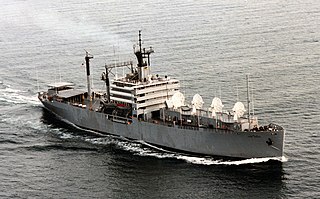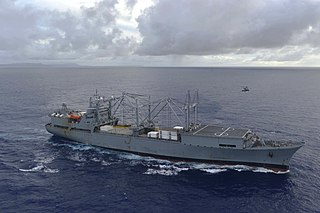Related Research Articles

Scrap consists of recyclable materials, usually metals, left over from product manufacturing and consumption, such as parts of vehicles, building supplies, and surplus materials. Unlike waste, scrap can have monetary value, especially recovered metals, and non-metallic materials are also recovered for recycling. Once collected, the materials are sorted into types – typically metal scrap will be crushed, shredded, and sorted using mechanical processes.

A tracking ship, also called a missile range instrumentation ship or range ship, is a ship equipped with antennas and electronics to support the launching and tracking of missiles and rockets. Since many missile ranges launch over ocean areas for safety reasons, range ships are used to extend the range of shore-based tracking facilities.

The Type C4-class ship were the largest cargo ships built by the United States Maritime Commission (MARCOM) during World War II. The design was originally developed for the American-Hawaiian Lines in 1941, but in late 1941 the plans were taken over by the MARCOM.

The Type C5 ship is a United States Maritime Administration (MARAD) designation for World War II breakbulk cargo and later a container ship for containerization shipments. The first type C5-class ship was a class of ships constructed and produced in the United States during World War II. The World War II C5-class ship was dry bulk cargo ship built by Bethlehem Steel in Sparrows Point, Maryland. Bethlehem Steel built eight ships in this bulk cargo class and four orders were canceled. The C5-class ship has a 24,250 DWT and was 560 feet (170 m) long. The C5 was mainly used as iron ore carriers. The C5 was needed to replace other ships that sank during World War II. First in her class was SS Venore, USMC #1982, delivered on 20 July 1945. The Type C5-class ship designed to fill the need to move iron ore from Santa Cruz, Chile, to Sparrows Point, Maryland, through the Panama Canal, a round-trip of 8,700 nautical miles . Post World War II, four ships were given C5 class type C5-S-78a, these were roll-on/roll-off container ship built by Ingalls Shipbuilding, Inc. of Pascagoula, Mississippi and operated by the Moore-McCormack Lines. The C5-S-78a had a deadweight tonnage of 16,000 tons.

The Type L6 ship is a United States Maritime Administration (MARAD) designation for World War II as a Great Lakes dry break bulk cargo ship. The L-Type Great Lakes Dry Bulk Cargo Ships were built in 1943 to carry much-needed iron ore from the upper Great Lakes to the steel and iron production facilities on Lakes Erie and Ontario in support of the war effort. The ships have a 15,675 tonne deadweight tonnage. The L6 ships were built by two companies: American Ship Building Company, in the case of the type L6-S-A1 models, of which 6 were built; and Great Lakes Engineering Works, Ashtabula, Ohio/ Great Lakes Engineering Works, River Rouge, Michigan, in the case of the type L6-S-B1, which produced 10 ships. Steel supply needed for World War was great. To supply iron ore from Lake Superior to steel foundries, the United States Commission had a series of L6 Lakers ship built. The Maritime Commission ordered ten Great Lakes Bulk Carriers of the L6-S-B1 type. The L6-S-B1 was design with a 3-cylinder triple expansion steam engines. The L6-S-A1 used a lentz 4-cylinder compound engine. All L6 ships were coal burning and delivered between May and November 1943. L6-S-B1 was built for the US Maritime Commission under USMC contract MCc-1834 in 1943 at the River Rouge yard. Each L6 ship cost $2.265 million. The first L6-S-B1 was the SS Adirondack/Richard J. Reiss, hull 290, keel was laid on March 9, 1942 and launched on September 19, 1942. The ships are often called the Class Lake Bulk Freighter now.

The Type V ship is a United States Maritime Commission (MARCOM) designation for World War II tugboats. Type V was used in World War II, Korean War, and the Vietnam War. Type V ships were used to move ships and barges. Type V tugboats were made of either steel or wood hulls. There were four types of tugboats ordered for World War II. The largest type V design was the sea worthy 186-foot (57 m) long steel hull, V4-M-A1. The V4-M-A1 design was used by a number of manufacturers; a total of 49 were built. A smaller steel hull tugboat was the 94-foot (29 m) V2-ME-A1; 26 were built. The largest wooden hull was the 148-foot (45 m) V3-S-AH2, of which 14 were built. The smaller wooden hull was the 58-foot (18 m) V2-M-AL1, which 35 were built. Most V2-M-AL1 tugboats were sent to the United Kingdom for the war efforts under the lend-lease act. The Type V tugs served across the globe during World War II including: Pacific War, European theatre, and in the United States. SS Farallon, and other Type V tugs, were used to help built Normandy ports, including Mulberry harbour, on D-Day, 6 June 1944, and made nine round trips to Normandy to deliver Phoenix breakwaters.

The MLB Draft League is a baseball league that began play in 2021. Created by Major League Baseball (MLB) and Prep Baseball Report (PBR), the league operates a split-season format of 80 games with a hybrid amateur–professional structure: for the first half of the season, the league operates as an amateur collegiate summer baseball league to serve as a showcase for top draft-eligible prospects leading up to each July's MLB draft; after a break for the draft, play resumes for the season's remaining games with paid professional players who have exhausted their amateur eligibility.
References
- ↑ T. E. (Thomas Edward) Lawrence The Mint: A Day-book of the R.A.F. Depot Between August and December 1922, with Later Notes, CUP Archive, 1948 page 162